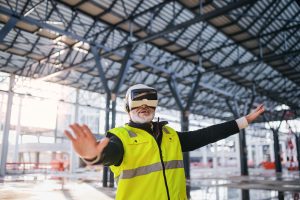Workplace health and safety training programs use virtual reality to recreate hazards, incidents, best practices, and more.

Photo credit: iStock.com/Halfpoint
Several industries are using virtual reality (VR) to deliver workplace health and safety training. Workers can don their headsets and see images that simulate real-life workplace experiences.
“The sky’s the limit. You can recreate any incident, any safe work practice,” says Stephen Sayle, CEO of a Halifax-based technological safety company in this OHS Canada article. “You can be immersed in those environments, sitting in the comfort of your own home.”
WorkSafeBC is developing a VR project specifically aimed towards youth who are new to the workforce. “VR is a tool that can engage young workers and future workers, and it introduces them to workplace safety in a fun way”, says Helen Chandler, one of WorkSafeBC’s occupational health and safety consultants for young workers. The project, called Camp Bearpaw, will take youth through an interactive experience of working at a summer camp, where they learn to identify hazards and mitigate risks.
Another example is one training specialist based in Prince George who is using VR for bear safety training.
“Physically and mentally interacting in the virtual world enhances the user’s learning experience and retention,” reads the VR Safety Training website. “High-risk training scenarios can be taught through VR in a safe environment with greatly reduced costs.”
(Read more about the hazards posed to workers by bears and other wildlife in wilderness areas in my post, Bare necessities of bear and wildlife safety.)
Touring Canada’s worksites virtually
Experience the Energy: Take the Tour is Energy Safety Canada’s VR tour of oil and gas worksites. It gives viewers a close-up look at the work people do in the energy industry, including conventional and automated drilling, steam-assisted gravity drainage, and work in processing facilities and on natural gas pipelines.
“Using virtual reality as a learning and training tool is quickly becoming an area of focus,” says Murray Elliott, president and CEO of Energy Safety Canada in this Canadian Occupational Safety article. “Some of the studies and data available suggest that you see improved training outcomes and reduced overall training time and costs.”
The future of mine training is VR, published by the Global Mining Review, describes another use of this technology. New workers can don their VR headsets and virtually inspect simulated versions of real-life mines. Experienced workers can use VR for incident reconstruction, emergency preparedness, and safety training.
“The programme is scenario-based and requires trainees to answer various safety-related questions as they maneuver through the mine,” reads the article. “Trainers interact with the trainees and monitor the progress of the training programme.”
In health care, workers use VR to learn how to put on and take off personal protective equipment (PPE) correctly. This video demonstrates the use of VR for PPE training. In addition to protecting workers and patients from the spread of COVID-19, training virtually helps the reduce waste of valuable equipment that is in short supply during the pandemic.
For more information on how the VR experience “…uses sight, sound and sometimes motion to provide a realistic experience,” see Virtual reality shakes up safety training in Canadian Occupational Safety.
What’s your experience with VR in safety training? Let me know in the comments below.
Experience the Energy: Take the Tour is Energy Safety Canada’s VR tour of oil and gas worksites. It gives viewers a close-up look at the work people do in the energy industry, including conventional and automated drilling, steam-assisted gravity drainage, and work in processing facilities and on natural gas pipelines.
“Using virtual reality as a learning and training tool is quickly becoming an area of focus,” says Murray Elliott, president and CEO of Energy Safety Canada in this Canadian Occupational Safety article. “Some of the studies and data available suggest that you see improved training outcomes and reduced overall training time and costs.”
The future of mine training is VR, published by the Global Mining Review, describes another use of this technology. New workers can don their VR headsets and virtually inspect simulated versions of real-life mines. Experienced workers can use VR for incident reconstruction, emergency preparedness, and safety training.
“The programme is scenario-based and requires trainees to answer various safety-related questions as they maneuver through the mine,” reads the article. “Trainers interact with the trainees and monitor the progress of the training programme.”
In health care, workers use VR to learn how to put on and take off personal protective equipment (PPE) correctly. This video demonstrates the use of VR for PPE training. In addition to protecting workers and patients from the spread of COVID-19, training virtually helps to reduce waste of valuable equipment that is in short supply during the pandemic.
For more information on how the VR experience “…uses sight, sound and sometimes motion to provide a realistic experience,” see Virtual reality shakes up safety training in Canadian Occupational Safety.
What’s your experience with VR in safety training? Let me know in the comments below.



This was a wonderful read! I think that occupational health and safety constantly needs to adapt and evolve, much like the workplace. I look forward to seeing how this evolves.
Thanks for your kind words! I’m always interested in seeing how evolving tech is put to use in workplace safety